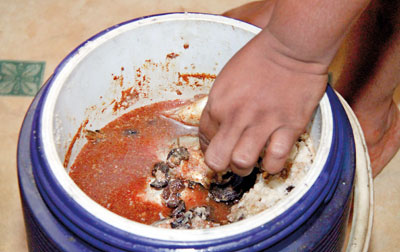News
Researchers warn of harmful bacteria in unhygienic salted fish
The age old tradition of preparing salted fish cured in goraka (gamboge) in the coastal belt of Sri Lanka on a commercial scale has come under fire by the Industrial Technology Institute (ITI), which warns of dangerous pathogens that could harm human health.

Jaadi prepared the traditional way can have up to 70% infection causing pathogens including microbes and fungi according to a study by the Industrial Technology Institute (file pic)
Research scientist Wasundera Divisekera said that the jaadi, a preparation made by fishing communities to preserve the excess fish harvest during peak seasons by soaking in salt water and goraka (garcinia cambogia/Malabar tamarind), can cause food poisoning and urinary tract infections.
She said that the jaadi prepared the traditional way can have up to 70% infection causing pathogens including microbes and fungi.
Tests on 12 samples of jaadi obtained from eight selected locations from the coastal belt from Galle to Chilaw including Balapitiya, Negombo and Kalutara, researchers found 15 organisms, of which two pathogens – the Acinetobacter baumannii and Staphylococcus, which infect the urinary tract were identified.
Interestingly, this counters the misconception that maggot-infested jaadi has the best taste and texture. Vendors claimed that in the past housewives only sought jaadi in such a rotten state. “This is a ruse adopted by the jaadi makers to boost their sales,’’ Ms Divisekera said.
Some of the raw ingredients create conditions for pathogens to thrive.
“The quality of water used and not considering contamination when preparing it, are contributing to the microbes settling in and multiplying, resulting in the spoilage quickly,’’ she said. Also a person eating jaadi for the first time could suffer food poisoning.
However there has been no study or research done on the effects of eating jaadi and urinary tract infections.
ITI scientist, Dr Samantha Madage, said that in the traditional method, jaadi makers use sea water and unclean vessels, usually clay vats and plastic barrel, that spoil the fish. Spoilt fish and stale spices used in the preparation can also create conditions for microbes.
The ITI is now introducing a more hygienic method to make jaadi.
Instead of sea water, they suggest salt dissolved in fresh water along with freshly prepared goraka.
Sea water is contaminated and salt-loving, halogenic bacteria can multiply freely, spoiling the product. In the end, the preparation is tested for its physical and microbial quality and purity.
Few people now eat jaadi. Over the generations, it has lost its value as an accompaniment or as an ingredient to cook with.
The ITI said that more and more traditional jaadi producers are adopting the safer method. Depending on the scale of the operation the output can go up to one metric ton per batch.
Jaadi has also found its way into overseas markets. Enterprising industries are exporting it in air tight jars to Sri Lankan expatriates who yearn for a taste from home.
| Jaadi maker adopts cleaner process | |
| Lucien Pieris, 63, from Paiyagala, Kalutara, who is involved in making jaadi for over 40 years, said that he no longer uses the traditional method. The ITI introduced hygienic method has improved the texture and taste of jaadi together with prolonged shelf life, increasing his income. “I produce up to 5,000 kilos and sell them within months of preparation and earn up to Rs 200,000 at a time,’’ he said. The fish he uses are haal masso (sprats) and linna (indian scad), among others. “We now can keep the product up to three years without spoilage. Earlier, the longest we could keep was three months,’’ he said. Some of his contemporaries are still clinging on to the traditional methods and are selling maggot-infested jaadi, he said. The salted fish is ready for use after a month. It is cooked in coconut sauce, (also coconut milk gravy) fried or tempered with onions, curry leaves, and green chilli, and is eaten with red rice and pol sambol. |

